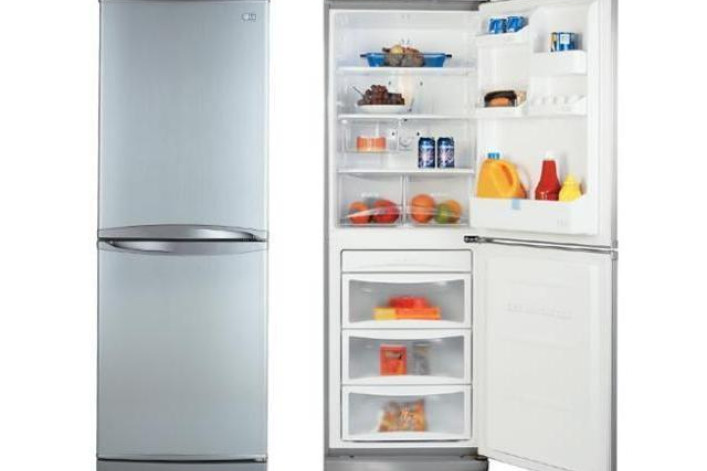NYC Renovation Chronicles: Trimming down the fridge

My New Year’s resolution was to trim the inches off. Not from myself, but from my kitchen appliances.
It was time to optimize the kitchen.
There was wasted space where we could have storage or more counter space. In a NYC kitchen, every inch counts, and the fridge was just too big.
At 18-cubic-feet it was smaller than what’s in most American households. But at 34” deep (including handles), it protruded almost a full extra foot into the small room, cutting it in half. Also, I didn’t like the proportions of freezer-to-fridge. Where the fridge was unnecessarily cavernous, the freezer was just a small box which you had to cram full of things without any organization at all, since there were no shelves or bins.
Of course, large fridges often make sense since packaging in the U.S. is much larger than anywhere else in the world that I know of. And for large families that do a lot of entertaining and have to drive to the store whenever they need anything, that’s fine.
But in Manhattan, I don’t have to walk more than a couple of blocks to a grocery or corner store. I pass some on my way home from the subway. In short, we have no need for such a large fridge. We decided it was time to invest in a counter depth (24”), apartment-sized unit.

The old fridge was cavernous and unused for the most part.
Online, I pored over reviews and comments for fridges that were less than the average 23 cubic feet capacity, mentally listing pros and cons for getting a smaller fridge. You see, everybody I talked to about it told me point blank I would be crazy to get a smaller unit.
"What if you throw a big party?" they asked.
Well, what if we do? I’m not going to start worrying about how to store large platters of canapes because that would mean I would have to start worrying about making large platters of canapes.
I wanted something that would work better, look better, and perhaps break us of the habit of keeping leftovers in tupperware until the contents take on the appearance of a green chinchilla.
Narrowing down the candidates for a smaller appliance was easy, since there isn’t much choice. There are only a handful of manufacturers of smaller units, such as Summit, Blomberg, Liebherr, LG. And they mostly cost so much more than standard sizes. Liebherr, Blomberg and other European manufacturers command prices upward of $2,500 for 10 − 13 cubic feet capacity models. Our budget was around $1,000 tops.

The Liebherr 13 cubic foot fridge is priced at around $3,000.
At that price, the pickings were slim, and we soon decided on an LG model with a bottom freezer and 10 cubic foot capacity. It had favorable reviews, and at around $899 before taxes, it was in our price range.
With our refrigerator/freezer selection done, we turned to the rest of the kitchen. With a smaller fridge and some clever planning, we would be freeing up about two feet of wall space and there would be space for an apartment-sized dishwasher, more counter space and storage. And why not get smaller oven-range and free up even more storage opportunity? We headed to P.C. Richard & Son to take a look at our options.

LG model with a bottom freezer and 10 cubic foot capacity ($900).
But to our surprise, as we hadn't seen any on their website, the store also had a lot of refrigerators on display with around 10 cubic feet capacity.
These included the LG model as well as several other “entry level” fridges (including Whirlpool), and a slightly more high-end Blomberg unit. But I was surprised, and a bit disappointed, at just how small the units looked from the inside. The LG and the Blomberg units had the same capacity, and were about $500 dollars apart in price.
If only there had been just one extra shelf. It would have made a huge difference. I suddenly hesitated about getting a smaller fridge at all. But my husband saw things differently. He loved the LG unit, pointing out that it was the same size, even larger, than the one his parents had raised three kids on. And luckily for us, the store was also having their annual Employee Sale, so the final cost to us, after the discounted price, after taxes, and a $60 delivery fee, still came to around the original sale price of $899.
Also, the store has a great policy: You can put down $100 to lock in the price, meaning we would still get the “Employee Discount” without committing to buying that day. The ‘price lock’ would be valid for however long they held our deposit, and we could get the deposit back any time. They also guaranteed to price match anything we saw in another store or online.
We left a deposit with the store. I wanted to have a look around the Internet one last time before making a decision. That’s when I found a Summit model with an almost 12 cubic foot capacity. It cost $300 dollars more than the LG, but the extra space and shelving made all the difference.

The winning model -- the Summit with almost 12 cu.ft -- costs about $1,200.
By coincidence, our next door neighbor was preparing her apartment for a year-long rental and wanted to update the appliances in her kitchen. We sold her our current fridge (a year and a half old) for $300. See how that worked out?
We called our P.C. Richard & Son sales person and told him about our change of heart. He told us he could sell me the same unit and match the price, and deliver it within the week. And, of course, they would dispose of the old appliance for me as well. For $1,225 total price (including taxes and delivery), we were sold.
On the day of delivery, my neighbor arranged to take my current fridge for her kitchen. My supermodel fridge (tall and skinny!) was delivered right on time, and the delivery men took my neighbor’s ratty old fridge with them.
Without doing any work to the kitchen (yet), the room is totally transformed already. It looks so much wider and people can actually walk past each other without turning sideways. Since we can’t stack junk (cereal boxes, salad spinner) on top of the fridge anymore (78” is too high for convenience), the kitchen is immediately neater. And, of course, the smaller capacity keeps everything nice and neat and accessible inside.
The extra inches of floor and wall space we gained due to the reduced width (from 34” to 24”) will come in handy when we plan out storage and counter space in the next phase of our kitchen spruce up. It may seem silly to fight for every inch of space, but it’s those inches and what you do with it that make all the difference.
NYC Renovation Chronicles is a bi-weekly column focused (obviously) on renovation, NYC style. Helmed in the past by an architect, a kitchen and bath designer, and a general contractor, the column's new steward is co-op renovator, real estate porn addict and Harlem resident Mayra David. She'll focus on what it's like to DIY or HSI (= Hire Someone Instead) in NYC.





















